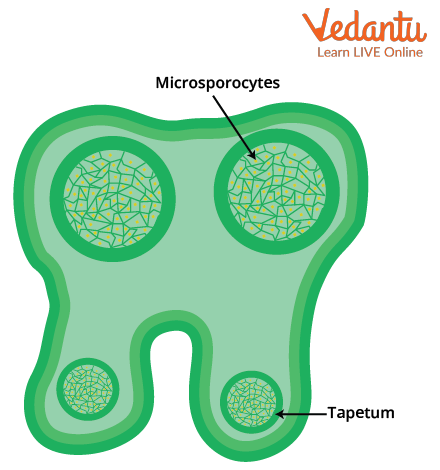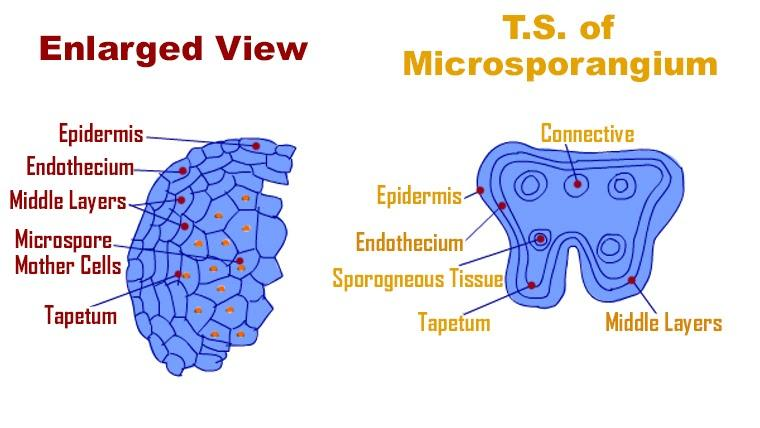How Does Tapetum Support Plant Development and Vision?
The concept of functions of tapetum is essential in biology and helps explain real-world biological processes and exam-level questions effectively. Understanding the role of tapetum is especially important for students preparing for class 12 board exams and medical entrance tests such as NEET.
Understanding Functions of Tapetum
Functions of tapetum refer to the various key roles played by the specialized nutritive cell layer found inside the anther of flowering plants. This concept is important in areas like pollen grain development, plant reproduction, and plant anatomy. In animals, a similar structure called the tapetum lucidum is found in the eyes of some night-vision adapted species.

Functions of Tapetum in Plants
The tapetum in plants is the innermost layer of the anther wall, directly surrounding the developing microspores (pollen grains). Its main functions include:
- Supplying nutrition to the developing microspores or pollen grains.
- Providing precursors for pollen wall (exine) formation, especially via secretion of sporopollenin (a durable biopolymer).
- Production and secretion of Ubisch bodies (or orbicules) that contribute to exine (outer wall) formation.
- Contributing pollenkitt—a sticky substance aiding pollen dispersal and recognition on the stigma.
- Secretion of enzymes like callase, which helps in separating pollen tetrads by breaking down callose walls.
- Producing proteins (exine proteins) crucial for pollen–stigma recognition during pollination.
Disintegration of tapetal cells at maturity provides further materials for pollen coat formation. An unhealthy or defective tapetum usually leads to pollen sterility and low fertility.
Types of Tapetum
Tapetum is generally classified into two main types based on behavior and function:
| Type | Description | Example |
|---|---|---|
| Glandular (Secretory) Tapetum | Tapetal cells remain in place, secrete materials into the locule | Angiosperms (most flowering plants) |
| Amoeboid (Plasmodial) Tapetum | Tapetal cells fuse and their protoplast invades the anther locule | Some aquatic/wetland plants (e.g., Alisma, Tradescantia) |
Mechanism of Tapetum Function
The basic mechanism involves continuous uptake and re-mobilization of nutrients, enzymes, and regulatory molecules by tapetal cells. These substances are then secreted toward developing microspores, promoting proper development, wall formation, and eventual pollen release.
Tapetum and Ubisch Granules
A notable function of the tapetum is the production of Ubisch bodies (orbicules). These are tiny, sporopollenin-coated particles secreted into the anther locule, helping in the formation and reinforcement of the pollen grain wall. This process is vital for pollen protection and viability.

Functions of Tapetum Lucidum (Eye)
Tapetum lucidum is the reflective layer found in the eyes of nocturnal animals (e.g., cats, dogs, deer), enhancing their night vision by reflecting light back through the retina. This is different from plant tapetum, but the function keyword sometimes overlaps in exam questions. In animals, it improves the ability to see in low light.
Functions of Tapetum – Quick Table Summary
Here’s a helpful table to compare tapetum in plants and animals:
| Feature | Plant Tapetum | Animal Tapetum (Eye) |
|---|---|---|
| Location | Anther, surrounding microspores | Behind retina of eye |
| Main Function | Nourish developing pollen, pollen wall formation | Enhance night vision by reflecting light |
| Example | Flowering plants | Cat, dog, deer |
Practice Questions
- List any four functions of tapetum in the anther.
- Explain the significance of tapetum in pollen wall formation.
- Name the two types of tapetum and mention their differences.
- What would happen if the tapetum is non-functional?
- What is the function of tapetum lucidum in animal eyes?
Common Mistakes to Avoid
- Confusing tapetum in plants with the tapetum lucidum in animal eyes.
- Forgetting tapetum's role in both nutrition and pollen wall formation.
- Not mentioning the role of tapetum in Ubisch body and pollenkitt production in exams.
Real-World Applications
The concept of functions of tapetum is used in fields like plant breeding, biotechnology, and crop fertility research. Defective tapetum often leads to male sterility in crops, which is used in hybrid seed production. Vedantu helps students relate such topics to practical examples they may encounter in labs or competitive exams.
In this article, we explored functions of tapetum, its key processes, real-life significance, and how to solve questions based on it. To learn more and build confidence, keep practicing with Vedantu.
What is Tapetum?
Anther
Pollen Grains
Stamen
Plant Tissues
Types of Pollination
Flower
Sexual Reproduction in Plants
Microsporogenesis
Cells
Plant Cell


FAQs on Functions of Tapetum: Roles, Types, and Significance Explained
1. What is the function of tapetum?
The tapetum is a specialized nutritive tissue found in the anther of flowering plants and the eyes of some animals. In plants, its main function is to provide nutrition and enzymes necessary for the development and maturation of pollen grains. In animals, especially nocturnal species, the tapetum lucidum enhances night vision by reflecting light back through the retina.
2. What is the role of tapetum in anther?
In the anther, the tapetum acts as the innermost layer surrounding the developing microspores. It supplies essential nutrition, regulatory molecules, and secretes enzymes like callase to facilitate pollen grain maturation. It also contributes to forming the pollen wall by providing precursors such as sporopollenin and releasing Ubisch bodies that thicken the pollen membrane.
3. What is the function of tapetum lucidum in the eye?
The tapetum lucidum is a reflective layer found in the eyes of many nocturnal animals, such as cats and dogs. Its primary function is to enhance night vision by reflecting light that passes through the retina back into the photoreceptor cells, thereby increasing light sensitivity in low-light conditions.
4. What are the types of tapetum?
There are mainly three types of tapetum in plants, categorized based on their cellular structure and mode of nutrient supply:
1. Secretory (Glandular) Tapetum – the tapetal cells remain intact and secrete nutrients into locule.
2. Amoeboid (Periplasmodial) Tapetum – tapetal protoplasts surround developing pollen in the locule.
3. Mixed Type – features characteristics of both secretory and amoeboid tapetum types.
This helps clarify confusion related to tapetum structure and function.
5. What is the function of tapetum and Ubisch granules?
The tapetum produces Ubisch granules (also called orbicules), which are small, sporopollenin-coated structures. These granules assist in the transport and deposition of sporopollenin to the developing pollen wall, thereby strengthening and protecting the pollen grains against environmental stresses.
6. Why do students confuse tapetum in plants and animals?
Students often confuse the tapetum in plants with the tapetum lucidum in animals because both share the same name but have unrelated functions. The plant tapetum nourishes developing pollen, while the animal tapetum lucidum is a reflective eye layer aiding night vision. Clear differentiation and examples help resolve this confusion.
7. Is the tapetum essential for pollen fertility?
Yes, the tapetum is essential for pollen fertility because it provides necessary nutrients, enzymes, and precursors that support pollen grain development. Without proper tapetal function, pollen grains may become nonviable or sterile, affecting plant reproduction.
8. Can you label the tapetum accurately in a diagram?
Yes, the tapetum is the innermost cell layer of the anther wall, surrounding the sporogenous tissue. In labeled diagrams, it appears between the middle layer and the developing pollen cells inside the microsporangium. Clear labeling aids exam accuracy and concept clarity.
9. How does tapetum affect MCQ choices in board exams?
Understanding the functions and types of tapetum is crucial for correctly answering MCQs in board and competitive exams. Questions often focus on its role in nutrition, pollen wall formation, secretion of enzymes, and differences between tapetum in plants and animals. Clear concept recall helps avoid common errors.
10. What happens if the tapetum layer is damaged?
Damage or malfunction of the tapetum results in inadequate nutrition and enzyme supply to developing pollen, causing impaired pollen development and reduced fertility or sterility. This can negatively impact plant reproduction and crop yield.
11. What causes tapetal cells to be multinucleate?
Tapetal cells become multinucleate because they undergo mitotic division without cytokinesis, meaning the nucleus divides but the cell itself does not. This results in large cells with multiple nuclei (polyploidy), which supports their nutrient-supplying role.










